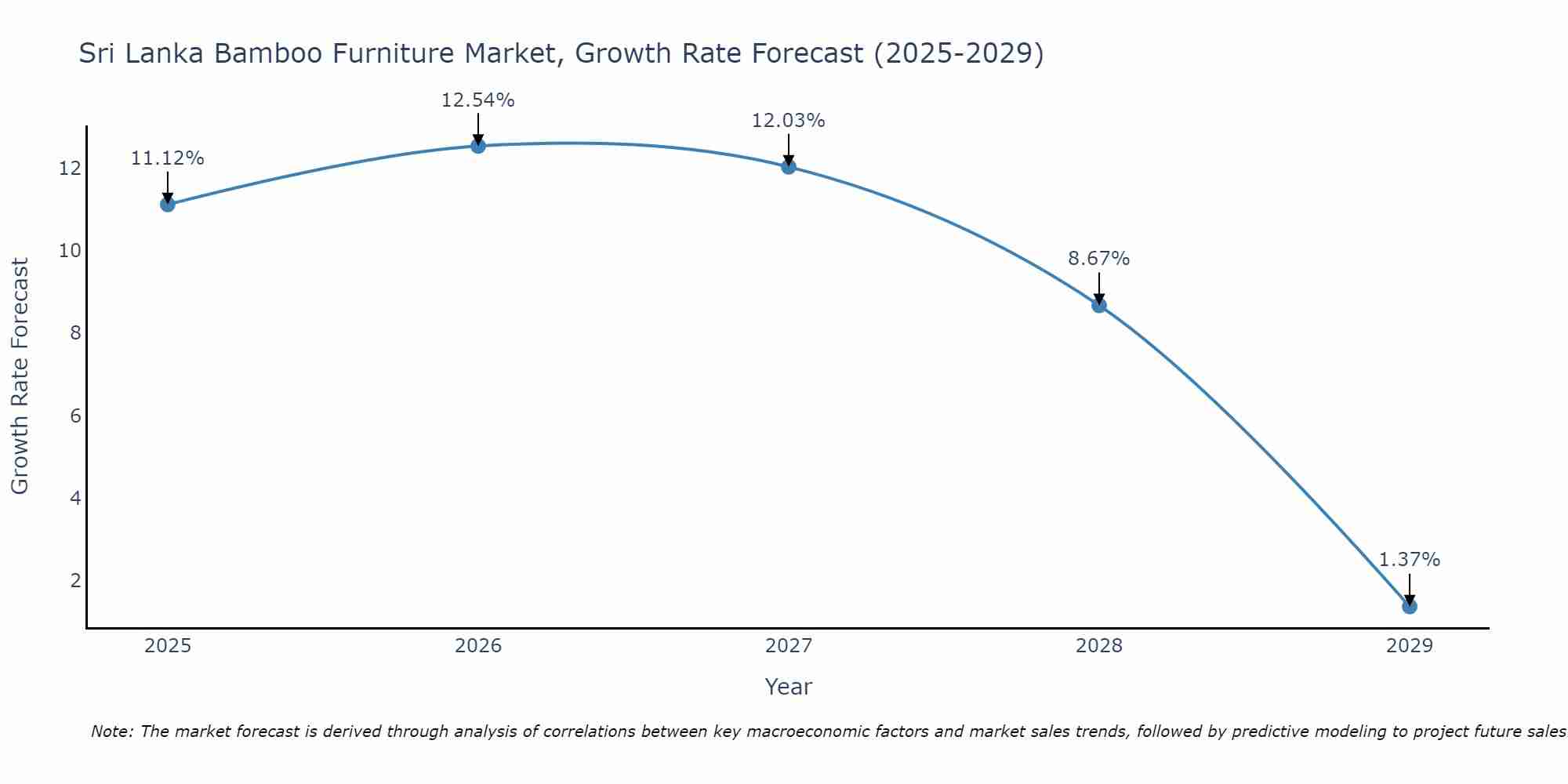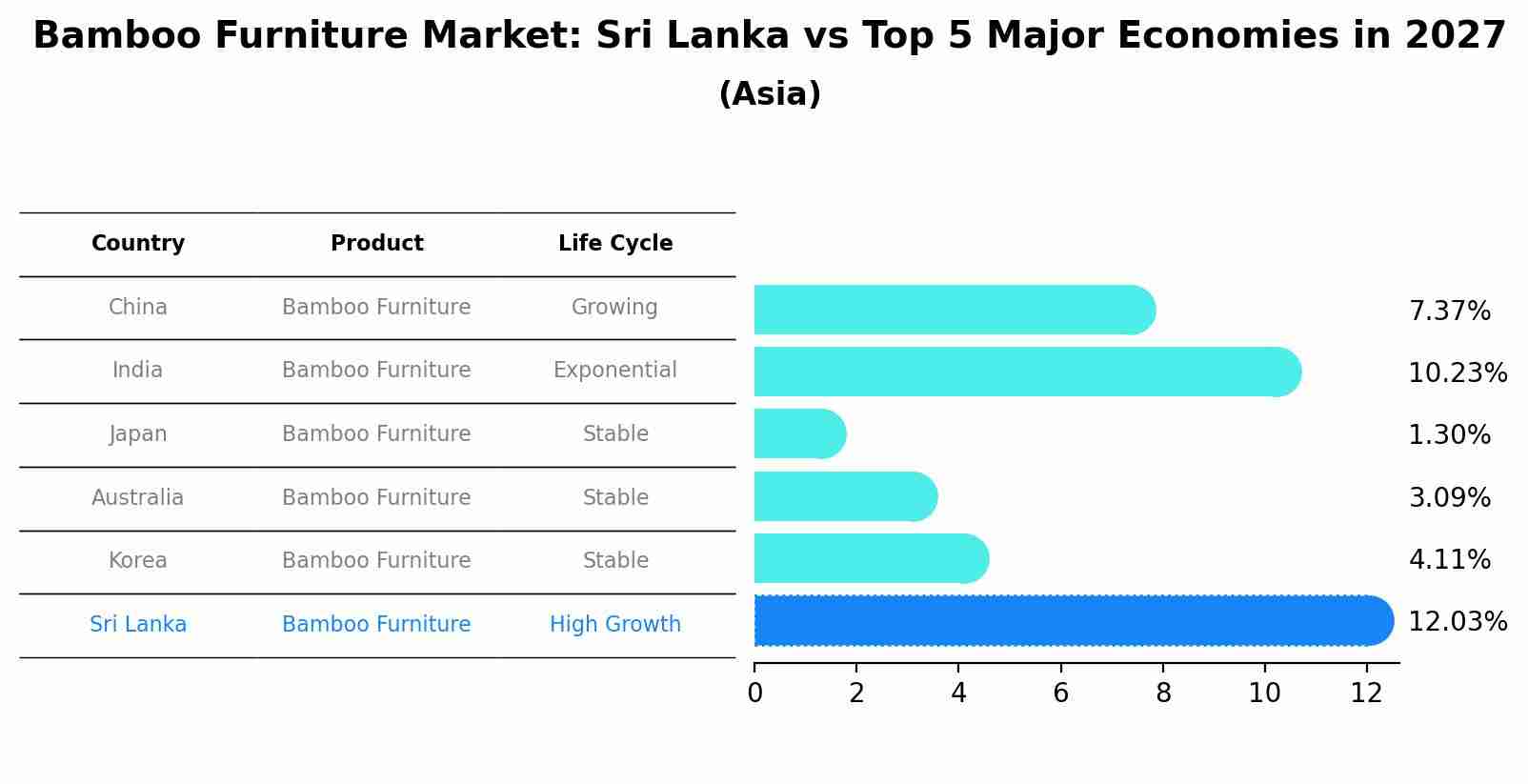Sri Lanka Bamboo Furniture Market (2025-2031) Outlook | Industry, Analysis, Revenue, Trends, Share, Companies, Size, Forecast, Growth & Value
| Product Code: ETC370891 | Publication Date: Aug 2022 | Updated Date: Jul 2025 | Product Type: Market Research Report | |
| Publisher: 6Wresearch | Author: Bhawna Singh | No. of Pages: 75 | No. of Figures: 35 | No. of Tables: 20 |
Sri Lanka Bamboo Furniture Market Size Growth Rate
The Sri Lanka Bamboo Furniture Market is projected to witness mixed growth rate patterns during 2025 to 2029. The growth rate begins at 11.12% in 2025, climbs to a high of 12.54% in 2026, and moderates to 1.37% by 2029.

Bamboo Furniture Market: Sri Lanka vs Top 5 Major Economies in 2027 (Asia)
The Bamboo Furniture market in Sri Lanka is projected to grow at a high growth rate of 12.03% by 2027, within the Asia region led by China, along with other countries like India, Japan, Australia and South Korea, collectively shaping a dynamic and evolving market environment driven by innovation and increasing adoption of emerging technologies.

Sri Lanka Bamboo Furniture Market Synopsis
The Sri Lanka Bamboo Furniture Market is experiencing steady growth due to the increasing popularity of sustainable and eco-friendly products. Bamboo furniture is known for its durability, light weight, and natural aesthetic appeal, making it a preferred choice for many consumers. The market is driven by the rising awareness of environmental conservation and the shift towards sustainable living practices among the population. Key players in the market are focusing on innovative designs, quality craftsmanship, and competitive pricing to cater to the growing demand. Additionally, the government`s initiatives to promote the use of bamboo as a sustainable building material are further boosting the market growth. Overall, the Sri Lanka Bamboo Furniture Market is poised for significant expansion in the coming years as more consumers prioritize sustainability in their purchasing decisions.
Sri Lanka Bamboo Furniture Market Trends
In the Sri Lankan Bamboo Furniture Market, sustainable and eco-friendly products are gaining popularity due to increasing consumer awareness about environmental conservation. There is a growing demand for bamboo furniture as it is seen as a renewable resource that helps reduce deforestation. Design trends are also leaning towards minimalistic and modern styles, with a focus on functionality and versatility. Customization options are becoming more prevalent as consumers seek unique pieces that reflect their personal style. Additionally, there is a rise in online sales platforms for bamboo furniture, offering a convenient shopping experience for customers. Overall, the market is witnessing a shift towards sustainable practices and innovative designs to cater to the evolving preferences of consumers in Sri Lanka.
Sri Lanka Bamboo Furniture Market Challenges
In the Sri Lanka Bamboo Furniture Market, one of the key challenges is the lack of awareness and understanding among consumers about the benefits of bamboo furniture compared to traditional wood furniture. This results in lower demand for bamboo furniture products and limits market growth opportunities. Additionally, the availability of high-quality bamboo materials and skilled artisans for crafting bamboo furniture can be limited, leading to potential supply chain issues and quality control concerns. Moreover, the perception of bamboo furniture as being less durable or stylish compared to other materials poses a challenge in attracting a wider customer base. Addressing these challenges through education, promotion of sustainable practices, and improving product quality and design can help unlock the full potential of the Sri Lanka Bamboo Furniture Market.
Sri Lanka Bamboo Furniture Market Investment Opportunities
In the Sri Lankan Bamboo Furniture Market, there are several investment opportunities worth exploring. With the global trend towards sustainable and eco-friendly products, bamboo furniture has gained popularity due to its durability, versatility, and environmental benefits. Investors can consider opportunities in manufacturing bamboo furniture for both domestic and export markets. Collaborating with local artisans and craftsmen to create unique and high-quality bamboo furniture pieces can be a profitable venture. Additionally, investing in research and development to innovate new designs and products that cater to changing consumer preferences can provide a competitive edge in the market. Overall, the Sri Lankan Bamboo Furniture Market offers promising investment prospects for those interested in sustainable and socially responsible business ventures.
Jordan Agar Market Government Policies
The Sri Lankan government has implemented various policies to support the bamboo furniture market in the country. These policies include providing financial incentives and subsidies to bamboo furniture manufacturers, promoting sustainable harvesting practices to ensure the long-term availability of bamboo resources, and encouraging research and development in bamboo furniture design and production techniques. Additionally, the government has focused on creating a conducive business environment for bamboo furniture industry players by streamlining regulations, offering tax breaks, and facilitating access to credit and export markets. Overall, these policies aim to boost the growth of the bamboo furniture market in Sri Lanka, enhance the competitiveness of local manufacturers, and promote the use of environmentally friendly and sustainable materials in the furniture industry.
Sri Lanka Bamboo Furniture Market Future Outlook
The future outlook for the Sri Lanka Bamboo Furniture Market looks promising, driven by the growing trend towards sustainable and eco-friendly products. Consumers are increasingly seeking furniture options that are not only stylish and functional but also environmentally responsible. Bamboo furniture, known for its durability, strength, and eco-friendly nature, is gaining popularity in the Sri Lankan market. The government`s initiatives to promote sustainable practices and the rising awareness among consumers about the benefits of bamboo as a renewable resource are expected to further boost the demand for bamboo furniture in the country. Additionally, the innovative designs and versatility offered by bamboo furniture manufacturers are likely to attract a wider customer base in the future, indicating a positive growth trajectory for the Sri Lanka Bamboo Furniture Market.
Key Highlights of the Report:
- Sri Lanka Bamboo Furniture Market Outlook
- Market Size of Sri Lanka Bamboo Furniture Market, 2024
- Forecast of Sri Lanka Bamboo Furniture Market, 2031
- Historical Data and Forecast of Sri Lanka Bamboo Furniture Revenues & Volume for the Period 2021 - 2031
- Sri Lanka Bamboo Furniture Market Trend Evolution
- Sri Lanka Bamboo Furniture Market Drivers and Challenges
- Sri Lanka Bamboo Furniture Price Trends
- Sri Lanka Bamboo Furniture Porter's Five Forces
- Sri Lanka Bamboo Furniture Industry Life Cycle
- Historical Data and Forecast of Sri Lanka Bamboo Furniture Market Revenues & Volume By Type for the Period 2021 - 2031
- Historical Data and Forecast of Sri Lanka Bamboo Furniture Market Revenues & Volume By Chairs & Tables for the Period 2021 - 2031
- Historical Data and Forecast of Sri Lanka Bamboo Furniture Market Revenues & Volume By Stools for the Period 2021 - 2031
- Historical Data and Forecast of Sri Lanka Bamboo Furniture Market Revenues & Volume By Beds for the Period 2021 - 2031
- Historical Data and Forecast of Sri Lanka Bamboo Furniture Market Revenues & Volume By Others for the Period 2021 - 2031
- Historical Data and Forecast of Sri Lanka Bamboo Furniture Market Revenues & Volume By End User for the Period 2021 - 2031
- Historical Data and Forecast of Sri Lanka Bamboo Furniture Market Revenues & Volume By Residential for the Period 2021 - 2031
- Historical Data and Forecast of Sri Lanka Bamboo Furniture Market Revenues & Volume By Commercial for the Period 2021 - 2031
- Sri Lanka Bamboo Furniture Import Export Trade Statistics
- Market Opportunity Assessment By Type
- Market Opportunity Assessment By End User
- Sri Lanka Bamboo Furniture Top Companies Market Share
- Sri Lanka Bamboo Furniture Competitive Benchmarking By Technical and Operational Parameters
- Sri Lanka Bamboo Furniture Company Profiles
- Sri Lanka Bamboo Furniture Key Strategic Recommendations
Frequently Asked Questions About the Market Study (FAQs):
- Single User License$ 1,995
- Department License$ 2,400
- Site License$ 3,120
- Global License$ 3,795
Search
Related Reports
- ASEAN and Thailand Brain Health Supplements Market (2025-2031) | Strategy, Consumer Insights, Analysis, Investment Trends, Opportunities, Growth, Size, Share, Industry, Revenue, Segments, Value, Segmentation, Supply, Forecast, Restraints, Outlook, Competition, Drivers, Trends, Demand, Pricing Analysis, Competitive, Strategic Insights, Companies, Challenges
- ASEAN Bearings Market (2025-2031) | Strategy, Consumer Insights, Analysis, Investment Trends, Opportunities, Growth, Size, Share, Industry, Revenue, Segments, Value, Segmentation, Supply, Forecast, Restraints, Outlook, Competition, Drivers, Trends, Demand, Pricing Analysis, Competitive, Strategic Insights, Companies, Challenges
- Europe Flooring Market (2025-2031) | Outlook, Share, Industry, Trends, Forecast, Companies, Revenue, Size, Analysis, Growth & Value
- Saudi Arabia Manlift Market (2025-2031) | Outlook, Size, Growth, Trends, Companies, Industry, Revenue, Value, Share, Forecast & Analysis
- Uganda Excavator, Crane, and Wheel Loaders Market (2025-2031) | Strategy, Consumer Insights, Analysis, Investment Trends, Opportunities, Growth, Size, Share, Industry, Revenue, Segments, Value, Segmentation, Supply, Forecast, Restraints, Outlook, Competition, Drivers, Trends, Demand, Pricing Analysis, Competitive, Strategic Insights, Companies, Challenges
- Rwanda Excavator, Crane, and Wheel Loaders Market (2025-2031) | Strategy, Consumer Insights, Analysis, Investment Trends, Opportunities, Growth, Size, Share, Industry, Revenue, Segments, Value, Segmentation, Supply, Forecast, Restraints, Outlook, Competition, Drivers, Trends, Demand, Pricing Analysis, Competitive, Strategic Insights, Companies, Challenges
- Kenya Excavator, Crane, and Wheel Loaders Market (2025-2031) | Strategy, Consumer Insights, Analysis, Investment Trends, Opportunities, Growth, Size, Share, Industry, Revenue, Segments, Value, Segmentation, Supply, Forecast, Restraints, Outlook, Competition, Drivers, Trends, Demand, Pricing Analysis, Competitive, Strategic Insights, Companies, Challenges
- Angola Excavator, Crane, and Wheel Loaders Market (2025-2031) | Strategy, Consumer Insights, Analysis, Investment Trends, Opportunities, Growth, Size, Share, Industry, Revenue, Segments, Value, Segmentation, Supply, Forecast, Restraints, Outlook, Competition, Drivers, Trends, Demand, Pricing Analysis, Competitive, Strategic Insights, Companies, Challenges
- Israel Intelligent Transport System Market (2025-2031) | Strategy, Consumer Insights, Analysis, Investment Trends, Opportunities, Growth, Size, Share, Industry, Revenue, Segments, Value, Segmentation, Supply, Forecast, Restraints, Outlook, Competition, Drivers, Trends, Demand, Pricing Analysis, Competitive, Strategic Insights, Companies, Challenges
- Uganda Precast and Aggregate Market (2025-2031) | Strategy, Consumer Insights, Analysis, Investment Trends, Opportunities, Growth, Size, Share, Industry, Revenue, Segments, Value, Segmentation, Supply, Forecast, Restraints, Outlook, Competition, Drivers, Trends, Demand, Pricing Analysis, Competitive, Strategic Insights, Companies, Challenges
Industry Events and Analyst Meet
Our Clients
Whitepaper
- Middle East & Africa Commercial Security Market Click here to view more.
- Middle East & Africa Fire Safety Systems & Equipment Market Click here to view more.
- GCC Drone Market Click here to view more.
- Middle East Lighting Fixture Market Click here to view more.
- GCC Physical & Perimeter Security Market Click here to view more.
6WResearch In News
- Doha a strategic location for EV manufacturing hub: IPA Qatar
- Demand for luxury TVs surging in the GCC, says Samsung
- Empowering Growth: The Thriving Journey of Bangladesh’s Cable Industry
- Demand for luxury TVs surging in the GCC, says Samsung
- Video call with a traditional healer? Once unthinkable, it’s now common in South Africa
- Intelligent Buildings To Smooth GCC’s Path To Net Zero













